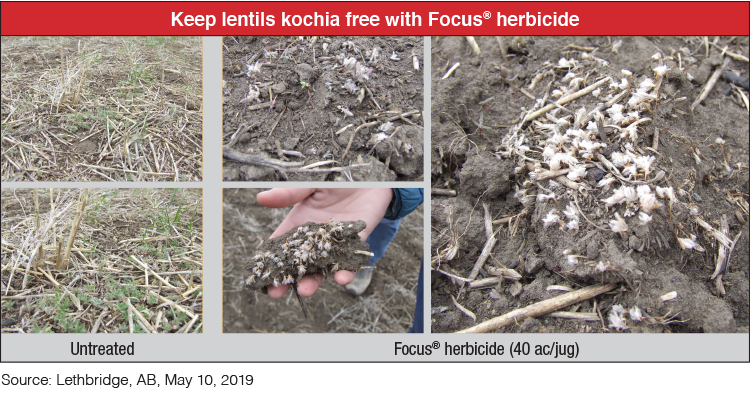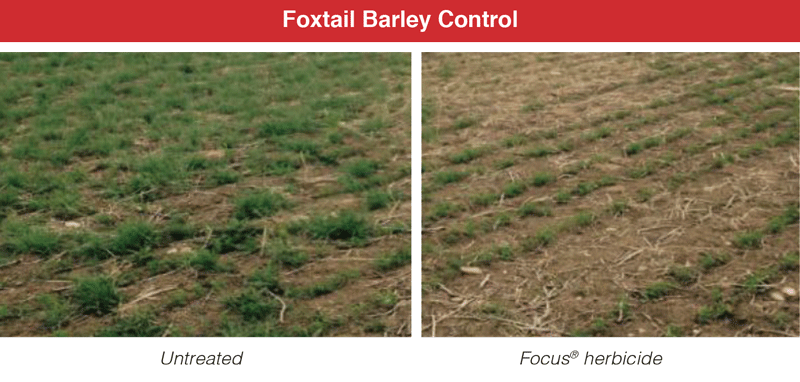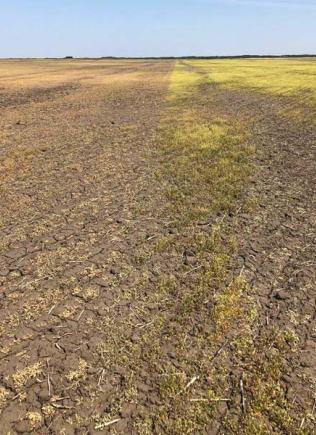Faits en bref
- Consistent burnoff and pre-emergent extended performance on tough-to-control grassy and broadleaf weeds.
- Concentrated liquid formulation.
- Multiple modes of action for resistance management.
- If there is a lack of adequate or normal soil moisture due to drought conditions, especially in June, July and August, following an application of Focus® herbicide, the minimum rotational crop interval described below must be extended for one additional year and a representative bioassay of the field must be conducted with the potential rotational crop and adequate soil moisture to determine the crop sensitivity to Focus® herbicide.
Aller à
Aperçu des produits
Focus herbicide provides extended control of a broad range of grassy and broadleaf weeds, helping create a weed-free period for your crop to thrive at a critical point in the growing season. The early-season weed control also gives you more flexibility to complete your in-crop applications in other crops.
Focus herbicide doesn’t bind to crop residues on the soil surface and can be tank-mixed with glyphosate for faster burnoff of emerged weeds. By combining modes of action from Groups 14 and 15, Focus herbicide gives growers an effective way to control weeds resistant to other modes of action, and also avoid the buildup of future weed resistance.
Apply Focus herbicide at either pre-seed or pre-emergence timing. Because it requires 15 to 25 mm of rain for activation, the product can be applied early in the season to maximize the chance of moisture activation. If you can’t be in the field to seed, or it’s too cool to spray glyphosate, that’s the time to get your Focus herbicide down.
Cultures
Blé de printemps
SUPPRESSION CIBLÉE POUR : Blé de printemps
Ce produit procure une suppression efficace contre les éléments suivants :
- Amarante à racine rouge
- Amarante hybride
- Gaillet gratteron
- Amarante rugueuse
- Abutilon
- Vélar fausse-giroflée
- Sétaire verte
- Sétaire glauque
- Échinochloa pied-de-coq
- Brome des toits
- Ivraie multiflore
- Digitaire sanguine
- Folle avoine
- Sétaire géante*
- Orge queue-d’écureuil*
- Tabouret des champs
- Kochia à balais*
- Chénopode blanc
- Renouée liseron*
- Moutarde des champs
- Morelle noire de l’Est
- Annual bluegrass
Blé d’hiver
SUPPRESSION CIBLÉE POUR : Blé d’hiver
Ce produit procure une suppression efficace contre les éléments suivants :
- Amarante à racine rouge
- Amarante hybride
- Gaillet gratteron
- Amarante rugueuse
- Abutilon
- Vélar fausse-giroflée
- Sétaire géante*
- Sétaire glauque
- Échinochloa pied-de-coq
- Brome des toits
- Ivraie multiflore
- Digitaire sanguine
- Folle avoine
- Sétaire géante*
- Orge queue-d’écureuil*
- Tabouret des champs
- Kochia à balais*
- Chénopode blanc
- Renouée liseron*
- Moutarde des champs
- Annual bluegrass
- Morelle noire de l’Est
Lentilles
SUPPRESSION CIBLÉE POUR : Lentilles
Ce produit procure une suppression efficace contre les éléments suivants :
- Amarante à racine rouge
- Amarante hybride
- Gaillet gratteron
- Amarante rugueuse
- Abutilon
- Vélar fausse-giroflée
- Sétaire verte
- Sétaire glauque
- Échinochloa pied-de-coq
- Brome des toits
- Ivraie multiflore
- Digitaire sanguine
- Folle avoine
- Sétaire géante*
- Orge queue-d’écureuil*
- Tabouret des champs
- Kochia à balais*
- Chénopode blanc
- Renouée liseron*
- Moutarde des champs
- Annual bluegrass
- Morelle noire de l’Est
Maïs (de grande culture)
SUPPRESSION CIBLÉE POUR : Maïs (de grande culture)
Ce produit procure une suppression efficace contre les éléments suivants :
- Amarante à racine rouge
- Amarante hybride
- Gaillet gratteron
- Amarante rugueuse
- Abutilon
- Vélar fausse-giroflée
- Sétaire verte
- Sétaire glauque
- Échinochloa pied-de-coq
- Brome des toits
- Ivraie multiflore
- Digitaire sanguine
- Folle avoine
- Sétaire géante*
- Tabouret des champs
- Kochia à balais*
- Chénopode blanc
- Renouée liseron*
- Moutarde des champs
- Annual bluegrass
- Morelle noire de l’Est
Soya
SUPPRESSION CIBLÉE POUR : Soya
Ce produit procure une suppression efficace contre les éléments suivants :
- Amarante à racine rouge
- Amarante hybride
- Gaillet gratteron
- Amarante rugueuse
- Abutilon
- Vélar fausse-giroflée
- Sétaire verte
- Sétaire glauque
- Échinochloa pied-de-coq
- Brome des toits
- Ivraie multiflore
- Digitaire sanguine
- Folle avoine
- Sétaire géante*
- Tabouret des champs
- Kochia à balais*
- Chénopode blanc
- Renouée liseron*
- Moutarde des champs
- Annual bluegrass
- Morelle noire de l’Est
Liste complète des cultures
- Corn (Field)
- Soybeans
- Spring Wheat
- Winter Wheat
- Lentils
- Field Peas
- Sunflower
REGISTERED PROVINCES
- Alberta
- Saskatchewan
- Manitoba
- British Columbia
Spécifications du produit
Spécifications techniques
Chemical Group: Groups 14 & 15
Registered and Supported Tank Mixes:
- Glyphosate, 2, 4-D Ester (spring and winter wheat, except durum)
- Engenia herbicide
- Express SG herbicide (soybean, spring (except durum) and winter wheat, field peas)
- Express FX herbicide (spring (except durum) and winter wheat)
- Intruvix herbicide
- Roundup Xtend
- XtendiMaX
Timing: Focus herbicide can be applied pre-plant or pre-emergence. Requires a minimum of 1/2" of moisture, at oncem for activation. Should be planted a minimum of 2.5 cm deep for wheat, corn and lentils; 4 cm deep for soybeans
Application Information:
- Apply pre-plant or post-seed (up to 3 days after seeding)
- Early application (pre-plant) increases activation potential via spring showers. Post-seed application should be considered in higher disturbance situations.
- Apply at 33 or 40 ac/jug, based on soil characteristics
- Apply with or without glyphosate. Apply with glyphosate if weeds are emerged and actively growing.
- Apply only once per 12-month period.
- Do not apply Authority Supreme herbicide (or any other product containing pyroxasulfone) in the spring to fields that were treated with applications of Focus herbicide (or any other product containing pyroxasulfone) during the previous fall. DO NOT follow a fall application of Focus herbicide (or any other product containing pyroxasulfone) with a spring application of Authority 480 herbicide (or any other product containing sulfentrazone) to fields where wheat will be planted. Focus herbicide control weeds germinating within the soil barrier.
Rates and Packaging: 4 x 4.5 L jugs per case. Ech 4.5 L jug treats 33 acres / jug at 136 mL/ac (336 mL/ha) or 40 acres/jug at 113 mL/ac (280mL/ha).
Surfactant: Not needed when mixed with glyphosate.
Water Volume: 10 gal/ac (100 L/ha)
Mixing Instructions: Fill spray tank one-half to two-thirds full of water. With agitator operating, add the recommended amount of ingredients using the WAMLEGS order.
Rainfastness: N/A
Crop rotation:
|
Rotational Crop |
Replant Interval (Months) |
|
Immediately |
Corn (field), lentils, soybeans, wheat (spring and winter, excluding durum) |
|
12 Month |
Chickpeas, field peas, flax, sunflower, safflower, barley, canola, mustard, oats, durum wheat |
|
Following spring |
Sugar beet |
|
|
|
Données des essais



Always read and follow label instructions. Member of CropLife Canada.
FMC, the FMC logo and Focus are trademarks of FMC Corporation or an affiliate.
Inscrivez-vous
Commencez à recevoir des informations agronomiques localisées et en temps utile de la part de FMC.


